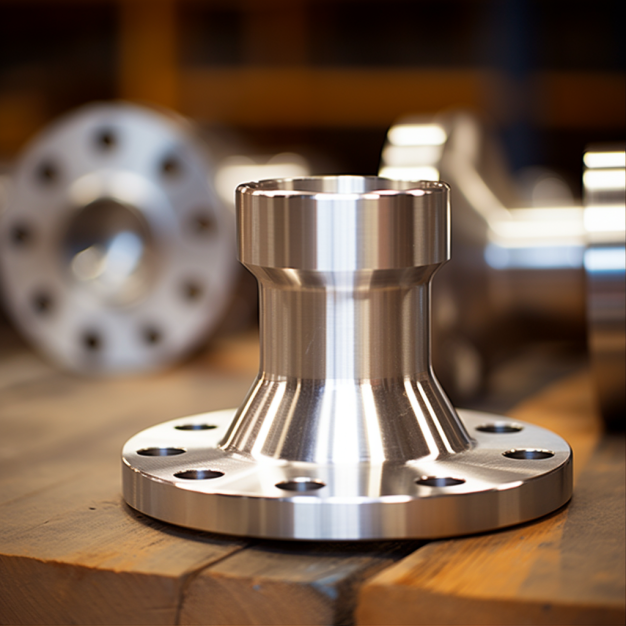Weld neck flanges, also known simply as weld flanges, are a common type of flange used to join piping systems in a wide variety of industrial processes. As an integral part of ensuring the safety and reliability of piping systems, understanding weld neck flange specifications is critically important. This article will provide an overview of key weld neck flange specifications and discuss their significance.

Basic Weld Neck Flange Design
At its most basic level, a weld neck flange consists of a welded pipe stub that extends from the end of a pipe. The stub is typically cylindrical in shape with a raised "neck" section that provides the welding surface to join the flange. A circular flange face, which is usually machined or beveled, sits atop the neck and provides the mounting surface to join two flanges together via bolting. Gasket surfaces are located on the inside diameter of the flange faces to create a seal when bolted.
The geometry of the weld neck, including its diameter, wall thickness, and other dimensions, are precisely controlled through manufacturing specifications. This ensures the strength and structural integrity of the weld joint between the pipe and flange. Common material options for weld neck flanges include carbon steel, stainless steel, alloy steels, and high temperatures alloys like nickel alloys.
ANSI/ASME Flange Specifications
In the United States, the American National Standards Institute (ANSI) and The American Society of Mechanical Engineers (ASME) jointly publish standard specifications for Weld Neck Flanges and other flanged fittings. The ASME B16.5 specification covers steel pipe flanges and flanged fittings with pressures classes up to 2500 lbs and temperatures from -100°F to 800°F.
Key aspects governed by B16.5 include flange pressure ratings, materials of construction, flange bore sizes, bolt hole count and spacing, face and face design, weld neck dimensions, and marking/stamping requirements. Proper specification of these factors ensures flanges can withstand system pressures, meet material compatability requirements, and join together in the field.
B16.5 specifies eight pressure classes for carbon steel weld neck flanges ranging from 150 lbs to 2500 lbs. Higher pressure classes require increased flange thickness and bolt hole count/diameter. Material grades are also specified to match pressure class capabilities. Compliance with B16.5 provides design consistency across manufacturers and projects.
Other Important Specifications
In addition to ASME B16.5, other recognized standards provide guidance on weld neck flanges in specialized applications and industries:
- ASME B16.47 Series A - High temperature flanges rated from 2000# to 4500# for temperatures to 1000°F.
- MSS SP-44 - Standardizes weld neck flange dimensions for use with steel pipe fittings in petrochemical applications.
- DIN EN 1092-1 - European standard covering flanges and their joints, including weld neck flange designs.
- MIL-F-18247 - U.S. military standard specifying flanges for ordnance hydraulic and pneumatic systems.
Compliance with applicable standards ensures flanges can withstand system conditions like high pressures, temperatures, or corrosive chemicals. It also promotes interchangeability of components between projects.
Other Critical Weld Neck Flange Specifications
Beyond the governing dimensional and pressure standards, other key specifications impacting weld neck flange selection and design include:
Material Grade
Carbon steel, stainless steel, and alloy material grades are specified to withstand system pressures, temperatures, and corrosion factors. Higher grades provide increased strength.
Welding Requirements
Weld neck flange joints require full penetration welds certified to codes like ASME Section IX or AWS D1.1. Proper welding procedures are critical for structural integrity.
Surface Finish
Machined/rolled flange faces facilitate accurate bolt-up and sealing. Rough or porous surfaces can cause leakage. Face finishes are often specified.
Markings
Welded flanges require marking of size, ratings, material, and manufacturer to ensure traceability and compliance with applicable codes and standards.
Gasket Compatibility
Flange dimensions, surface finish, and material must be compatible with standard gasket styles like ring joints, spiral wound, or heat resistant types.
Inspection and Testing
Weld neck flanges typically require NDT of welds, dimensional inspection, and hydrotesting to validate structural and pressure retaining capabilities.
Conclusion
In summary, proper specification of critical design factors like pressure ratings, materials, dimensions, finishes, markings and inspection/testing for weld neck flanges is essential for their safe and reliable use in industrial piping systems. Following relevant standards helps ensure consistent performance in line with intended service conditions. With their robust design and ability to meet diverse application needs, weld neck flanges will continue serving as a workhorse component in process piping for many industries.

